|
|||||
FlyingRC.net is a
Veteran-Owned site.

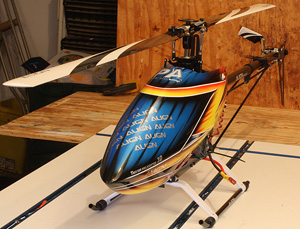 |
A photo just does not do the size of the T-Rex 550E PRO DFC justice. Despite it's size it is as nimble as they come in the air> Click image to enlarge |
Align T-Rex 550E PRO DFC
A 550 in 600 clothing – sort of
Text, photos and video by Tom Hintz
Posted - 11-24-2013
A few months ago I had given up RC helicopters because the effort was loaded with crash heavy frustration. Then I noticed all of the Align helicopters at our field and began wondering if I had the wrong helicopter. After more observing who was having fun flying their helicopters I got the Trex 450 Pro. Suddenly I was flying way more and crashing only when plagued by “dumb thumbs” rather than the helicopter going rogue and chasing another new vibration which it “cured” by rolling over. Now that I am enjoying flying helicopters and making obvious progress in my flying skills wanting a bigger one was only natural. Observation at the field again showed me that the Align T-Rex 500-550 class ships were very popular and recommended by their owners. Soon I had the T-Rex 550E PRO DFC and my enthusiasm for Align products goes up sharply.
The Basics
The new T-Rex 550E PRO DFC is a conflicted helicopter, but in a good way. Align apparently wanted to see how a “hopped-up” 550 class heli would sell so they took their popular 550 class machine and added a 600 tail boom system along with a 600 DFC rotor head with 520mm blades. Giving it all that lift capability meant upgrading the power with a 700 class, 730MX (850KV) motor. What you get is a level of performance that wildly exceeds my current capabilities but in a platform that is super stable and easy for a novice like me to fly and learn on.
The T-REX 550E PRO DFC Kit comes with a pair of 520 3G Carbon Fiber Blades, a set of 90mm Carbon Fiber Tail Blades, a 730MX Brushless Motor (850KV), 3 DS615 Digital servos, 1 DS655 Digital servo (rudder) and a Castle Talon 90 Brushless ESC.
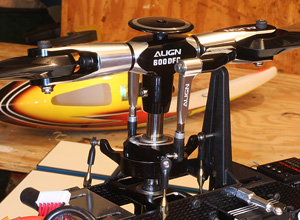 |
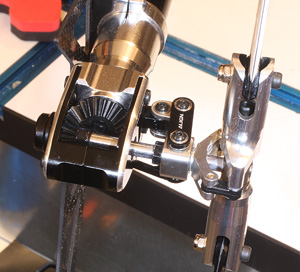 |
The T-Rex 550E PRO DFC comes with the 600 DFC head (right) and a 600 tail boom with the new 600 tail rotor gear drive. (right) Both are well made and tough. Click images to enlarge |
|
What set this particular kit apart for me was that it comes with a full 600 tail boom and a new design tail drive system featuring a 254mm tail rotor diameter. This system uses a dual point tail pitch control that makes for smoother, more precise tail response. It also has a full 600 DFC rotor head that with the 600 tail boom lets you use 600mm blades without interference with the tail rotor.
With everything else that 730MX (850KV) motor, originally found in a 700 class heli gives the T-Rex 550E PRO DFC an unusual level of power for the pilots who try to tear the sky open with violent-looking 3D tricks. For the novice like me the efficiency of the motor means that I can hover and do my limited forward flight stuff for 6 minutes and still have 45% and more left in my 6S 5000mAh LiPo packs! The chassis of the T-Rex 550E PRO DFC is based around 2mm thick 3K carbon side plates that give that motor a rigid foundation.
All of this comes in a heli that is 1160mm-long, 330mm-tall and just 110mm-wide! The 520mm blades on the 600 rotor assembly produce a rotor disc 1188mm-in diameter. The all-up weight as it flies, including a 6S 5000mAh pack totals out at about 8-lbs! I would find at the field that means LOTS of performance.
Assembly
Building the T-Rex 550E PRO DFC went easily. I had assembled my Trex 450 Pro and it turns out that the T-Rex 550E PRO DFC is very much the same, just larger. I should caution the inexperienced that some of the major assemblies like the rotor head, tail rotor drive and main/autorotation gear set come assembled from the factory. However, many of the fasteners are left loose! They tell you that in the instruction manual but I have dealt with the general public for too long to expect many of you to read that. You should though as it tells you what parts need to have thread locker applied. Nearly all of the T-Rex 550E PRO DFC uses medium (releasable) lock so you can get it apart for repairs and maintenance.
I put in two good days of work to assemble the T-Rex 550E PRO DFC. I was taking my time and making sure I had each step right before moving on. It looked very big. I set my T-Rex 450 next to it and will never understand the logic between the size difference between a 450 and 550. I also spent about an hour going through the setup of the servo arms, linkages and blade angles. Here again my experience with the T-Rex 450 helped a lot s most things are the same on the T-Rex 550E PRO DFC.
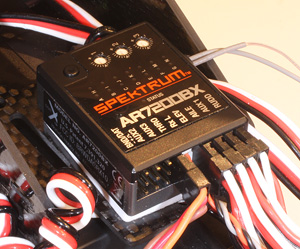 |
Align does have its own flybarless system but I and many of the heli guys at my field are partial to the Spektrum AR7200BX with the BeastX system built-in. Click image to enlarge |
Flybarless System
I am a fan of the Spektrum AR700BX receiver with the BeastX Flybarless system built in. I set up my Spektrum DX for a new heli and went through the steps in the AR7200BX manual. That took all of half an hour and I had a flight-ready T-Rex 550E PRO DFC! Naturally since I am a rank novice I set everything for a mild heli and the AR7200BX and the T-Rex 550E PRO DFC cooperated in that effort!
In the Air
The maiden flight in my back yard showed that I hated normal mode so after just a bit of that I landed and restarted in idle up 1 which was using 75% throttle. The T-Rex 550E PRO DFC spooled up nicely and lifted off cleanly. Right from the start this thing was near perfect. I would over the coming few days dial in a few “clicks” of right and a bit of forward trim (in the AR7200BX, not the radio) but that was all it took to hover cleanly and even move about the yard.
Because I finished building my T-Rex 550E PRO DFC on the Wednesday before our helicopter fly-in I literally did the full maiden flight at that event. I fully intended on sticking to hovering around the larger runway and maybe doing a little half-pipe back and forth but the T-Rex 550E PRO DFC felt so good I expanded my moves to turning it nose in and flying it back to me when I got too far out by accident. Though I did fly it four times at that event I stuck with the hovering around routine because of the large number of people around.
The next morning, buoyed by flying the T-Rex 550E PRO DFC back to me I went back out to the field and found that I could fly large ovals following the traditional traffic pattern around the field. I also did a figure-8 and was able to bring it back to me, flare and turn it and stop sort of right in front of me. Certainly not expert by any means but light years of improvement in the time it took to build and shake out the T-Rex 550E PRO DFC. I was absolutely giddy.
I decided to wait a few days before writing this “In the Air” section to let some of my giddiness to subside to be sure I was not overstating the capabilities of the T-Rex 550E PRO DFC. But cooling off did nothing to lessen my confidence in the T-Rex 550E PRO DFC. I know some of my sudden advancement in flying capability comes from being able to see the much larger T-Rex 550E PRO DFC better and the inherent stability of a larger, more stable model. But, this helicopter flies so nicely and is so consistently predictable that I was confident when making the jump from hovering to forward flight and banked turns.
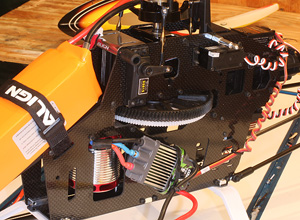 |
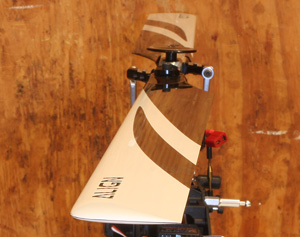 |
The heavy side plates (left) make this a strong helicopter. You can also see the Castle Talon 90 that is included as well as the big 730MX motor. All that lets you turn up to 600mm blades though the 520mm ones (right) that comes with the T-Rex 550E PRO DFC seem to perform just fine. Click images to enlarge |
|
A week later I returned to the field for the third day with my new T-Rex 550E PRO DFC and managed to repeat the forward flight movements more smoothly and with a growing confidence. I also managed to add loops and rolls to my forward flight. Many of the loops and rolls were less than perfect but they got better through the day and I missed the ground during all of them. I did manage to totally whiff on the collective during one roll and sort of slammed on the brakes with the T-Rex 550E PRO DFC upside down, tail down and falling. I got it righted and punched the collective and it went back up and flew away. Another first, my first big save that I believe was made easier by the ease with which the T-Rex 550E PRO DFC flies.
On that last flying day I was able to fly my ovals and figure eights at speed and was frankly amazed at how fast the T-Rex 550E PRO DFC is. It covers lots of ground quickly but I was able to keep it in the airspace easily with banked turns that have been getting cleaner and cleaner as I rack up flight time.
The simple facts are that the T-Rex 550E PRO DFC flies very well, responds predictably to flight commands and has no built in bad habits that I am aware of. The design is solid and the parts made well. There are no vibrations that compromise the Flybarless system and the DFC head makes setup simple and very straight forward.
When I first built this T-Rex 550E PRO DFC I set the total pitch angle to 12-degrees positive and negative. The collective felt just a bit touchy to me at first but I have since become accustomed to it and have not changed the setting. In fact the only change to the initial flight setup was adding two bumps of right and one of forward in the AR7200X BeastX. That’s it!
This kit comes with a Castle Talon 90 ESC (electronic speed control) and while I have heard knocks on its reliability or overall power capacity I have had no issues. I know of several others using the same ESC in 550-class helicopters and they also are having no problems.
The only ESC-related problem I had came when finding a place to mount it. There is lots of room inside and out of the frame structure but the short leads coming out of the motor really limit placement if you do not want to make extensions. I found that I could file a small recess in the motor opening on the left side of the frame, point the wires out there when mounting the motor and then mount the Talon 90 on the side there. There is just enough length of the power wires to reach the battery. A couple more inches of wire would be a nice addition to both the motor and ESC.
Conclusions
Video Tour |
|
The T-Rex 550E PRO DFC is a remarkable helicopter with all of the qualities we want and no bad ones that I can find. All of the components are well made and the kit is easy to assemble. The instruction manual is pretty good though a bit crowded as they try to present lots of information on each page. If you take your time and read the manual it really does walk you through the construction pretty well. I never felt lost and only had to go back and swap two ball link positions that I had messed up. That turned out to be the only error during construction.
With a street price of $781.00 (11-19-2013, Helidirect.com) the T-Rex 550E PRO DFC kit (no Flybarless system) is not cheap in terms of dollars but I think it is one of the better deals in the helicopter marketplace for what you wind up with. The wide availability of Align parts and aftermarket bling means that “accidental landing” downtime will be short.
I know the traditional thinking is to start with a smaller helicopter and then work up through several model sizes to something on the scale of the T-Rex 550E PRO DFC. Now having flown several helicopters from a 120 non-collective to my T-Rex 550E PRO DFC I think the argument can be made that with some help a new pilot just might learn faster with the T-Rex 550E PRO DFC as a first “larger” helicopter once they become accustomed to a little one in the 120 range.
And just in case you are wondering, NO I am not selling my T-Rex 550E PRO DFC! You are going to have to get your own. I expect that I will buy another helicopter (it will be an Align) but the T-Rex 550E PRO DFC is here to stay because is just too much fun and I have not even begun to max out what it is capable of!
Visit the T-Rex 550E PRO DFC product page – Click Here
Have a comment on this review? –Email Me!
All Flyingrc.net written, photographic and drawn materials are property of and copyright by Tom Hintz and Flyingrc.net 2013-2020 Materials cannot be used in any way without the prior written permission of the owner.
Privacy Statement


